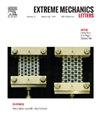光电机械带的光学穿透深度和周期性运动
IF 4.3
3区 工程技术
Q2 MATERIALS SCIENCE, MULTIDISCIPLINARY
引用次数: 0
摘要
含有光敏分子的液晶弹性体(LCE)在受到光照时会产生巨大的可逆变形。在此,我们研究了光穿透深度对这种光机械响应的作用。我们提出了光活性 LCE 带在光照下的光机械行为模型,该模型超越了浅穿透的常见假设。该模型揭示了光穿透深度以及由此引起的光机械变形如何取决于光活性分子的浓度、吸收截面和光照强度。通过一系列实例,我们表明穿透深度会对带材的光机械响应产生定量和定性影响。较浅的光照会导致单调的曲率变化,而较深的穿透则会随着光照时间的延长导致非单调的响应。此外,双夹紧和屈曲条带的拍打行为(循环波状运动)已被提出用于运动,在足够大的穿透深度下,这种拍打行为可以逆转方向。这为制造无线光驱动光机械致动器和游泳器提供了可能性,其运动方向可由光照强度和频率控制。本文章由计算机程序翻译,如有差异,请以英文原文为准。
Optical penetration depth and periodic motion of a photomechanical strip
Liquid crystal elastomers (LCEs) containing light-sensitive molecules exhibit large, reversible deformations when subjected to illumination. Here, we investigate the role of optical penetration depth on this photomechanical response. We present a model of the photomechanical behavior of photoactive LCE strips under illumination that goes beyond the common assumption of shallow penetration. This model reveals how the optical penetration depth and the consequent photomechanically induced deformation can depend on the concentration of photoactive molecules, their absorption cross-sections, and the intensity of illumination. Through a series of examples, we show that the penetration depth can quantitatively and qualitatively affect the photomechanical response of a strip. Shallow illumination leads to monotone curvature change while deep penetration can lead to non-monotone response with illumination duration. Further, the flapping behavior (a cyclic wave-like motion) of doubly clamped and buckled strips that has been proposed for locomotion can reverse direction with sufficiently large penetration depth. This opens the possibility of creating wireless light-driven photomechanical actuators and swimmers whose direction of motion can be controlled by light intensity and frequency.
求助全文
通过发布文献求助,成功后即可免费获取论文全文。
去求助
来源期刊

Extreme Mechanics Letters
Engineering-Mechanics of Materials
CiteScore
9.20
自引率
4.30%
发文量
179
审稿时长
45 days
期刊介绍:
Extreme Mechanics Letters (EML) enables rapid communication of research that highlights the role of mechanics in multi-disciplinary areas across materials science, physics, chemistry, biology, medicine and engineering. Emphasis is on the impact, depth and originality of new concepts, methods and observations at the forefront of applied sciences.
 求助内容:
求助内容: 应助结果提醒方式:
应助结果提醒方式:


